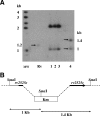Inactivation of Rv2525c, a substrate of the twin arginine translocation (Tat) system of Mycobacterium tuberculosis, increases beta-lactam susceptibility and virulence
- PMID: 16952959
- PMCID: PMC1595485
- DOI: 10.1128/JB.00631-06
Inactivation of Rv2525c, a substrate of the twin arginine translocation (Tat) system of Mycobacterium tuberculosis, increases beta-lactam susceptibility and virulence
Abstract
The twin arginine translocation (Tat) system is used by many bacteria to export fully folded proteins containing cofactors. Here, we show genetically that this system is essential for Mycobacterium tuberculosis, as the tatAC operon and tatB genes could be inactivated only in partially diploid strains. Using comparative genomics, the rv2525c gene of M. tuberculosis was identified as encoding a histidine-rich protein, with a twin arginine signal peptide, and orthologous genes were shown to be present in several but not all actinobacterial species. Conservation of this gene by Mycobacterium leprae, which has undergone reductive evolution, suggested an important role for rv2525c. An rv2525c knockout mutant was constructed, and biochemical analysis indicated that the mature Rv2525c protein is secreted. Upon exposure to antituberculous drugs, rv2525c expression is significantly up-regulated together with those of other genes involved in cell wall biogenesis. Phenotypic comparison of the mutant with the parental strain revealed an increase in susceptibility to some beta-lactam antibiotics and, despite slower growth in vitro, enhanced virulence in both cellular and murine models of tuberculosis. The Tat system thus contributes in multiple ways to survival of the tubercle bacillus.
Figures







Similar articles
-
Mycobacterium tuberculosis ECF sigma factor sigC is required for lethality in mice and for the conditional expression of a defined gene set.Mol Microbiol. 2004 Apr;52(1):25-38. doi: 10.1111/j.1365-2958.2003.03958.x. Mol Microbiol. 2004. PMID: 15049808
-
The twin-arginine translocation pathway of Mycobacterium smegmatis is functional and required for the export of mycobacterial beta-lactamases.J Bacteriol. 2005 Nov;187(22):7667-79. doi: 10.1128/JB.187.22.7667-7679.2005. J Bacteriol. 2005. PMID: 16267291 Free PMC article.
-
Structural studies suggest a peptidoglycan hydrolase function for the Mycobacterium tuberculosis Tat-secreted protein Rv2525c.J Struct Biol. 2014 Nov;188(2):156-64. doi: 10.1016/j.jsb.2014.09.003. Epub 2014 Sep 24. J Struct Biol. 2014. PMID: 25260828
-
Twin arginine translocation in Yersinia.Adv Exp Med Biol. 2007;603:258-67. doi: 10.1007/978-0-387-72124-8_23. Adv Exp Med Biol. 2007. PMID: 17966422 Review.
-
Protein export systems of Mycobacterium tuberculosis: novel targets for drug development?Future Microbiol. 2010 Oct;5(10):1581-97. doi: 10.2217/fmb.10.112. Future Microbiol. 2010. PMID: 21073315 Free PMC article. Review.
Cited by
-
Characterization of the proteasome accessory factor (paf) operon in Mycobacterium tuberculosis.J Bacteriol. 2007 Apr;189(8):3044-50. doi: 10.1128/JB.01597-06. Epub 2007 Feb 2. J Bacteriol. 2007. PMID: 17277063 Free PMC article.
-
Silencing Mycobacterium smegmatis by using tetracycline repressors.J Bacteriol. 2007 Jul;189(13):4614-23. doi: 10.1128/JB.00216-07. Epub 2007 May 4. J Bacteriol. 2007. PMID: 17483222 Free PMC article.
-
On a stake-out: Mycobacterial small RNA identification and regulation.Noncoding RNA Res. 2019 May 16;4(3):86-95. doi: 10.1016/j.ncrna.2019.05.001. eCollection 2019 Sep. Noncoding RNA Res. 2019. PMID: 32083232 Free PMC article. Review.
-
Systematic genetic nomenclature for type VII secretion systems.PLoS Pathog. 2009 Oct;5(10):e1000507. doi: 10.1371/journal.ppat.1000507. Epub 2009 Oct 30. PLoS Pathog. 2009. PMID: 19876390 Free PMC article. No abstract available.
-
The twin arginine translocation system is essential for aerobic growth and full virulence of Burkholderia thailandensis.J Bacteriol. 2014 Jan;196(2):407-16. doi: 10.1128/JB.01046-13. Epub 2013 Nov 8. J Bacteriol. 2014. PMID: 24214943 Free PMC article.
References
-
- Bange, W. R., F. M. Collins, and W. R. Jacobs, Jr. 1999. Survival of mice infected with Mycobacterium smegmatis containing large DNA fragments from Mycobacterium tuberculosis. Tuber. Lung Dis. 79:171-180. - PubMed
-
- Berks, B. C., F. Sargent, and T. Palmer. 2000. The Tat protein export pathway. Mol. Microbiol. 35:260-274. - PubMed
-
- Bogsch, E. G., F. Sargent, N. R. Stanley, B. C. Berks, C. Robinson, and T. Palmer. 1998. An essential component of a novel bacterial protein export system with homologues in plastids and mitochondria. J. Biol. Chem. 273:18003-18006. - PubMed
-
- Boshoff, H. I., T. G. Myers, B. R. Copp, M. R. McNeil, M. A. Wilson, and C. E. Barry III. 2004. The transcriptional responses of Mycobacterium tuberculosis to inhibitors of metabolism: novel insights into drug mechanisms of action. J. Biol. Chem. 279:40174-40184. - PubMed
Publication types
MeSH terms
Substances
LinkOut - more resources
Full Text Sources
Molecular Biology Databases

